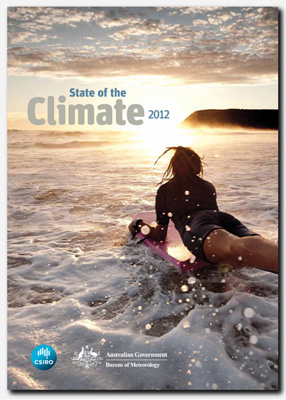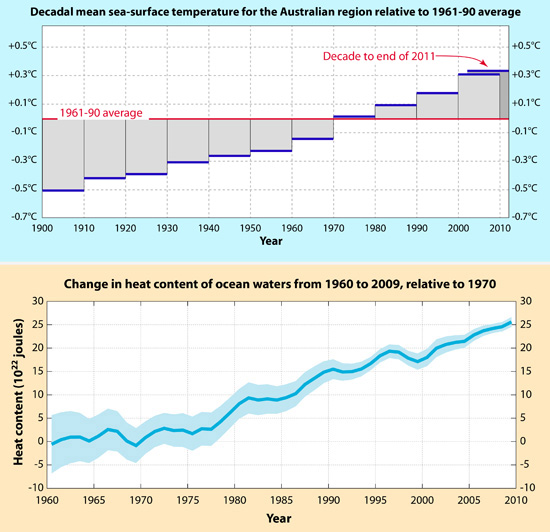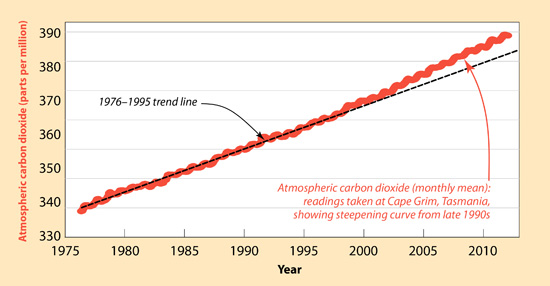Australia’s national climate research agencies have issued their direst warning yet about the state of the climate, but who’s listening? [20 March 2012 | Peter Boyer]
 The most remarkable thing about last week’s deceptively-brief “State of the Climate” report is not what it had to say — shocking though that is — but the political context in which it was said.
The most remarkable thing about last week’s deceptively-brief “State of the Climate” report is not what it had to say — shocking though that is — but the political context in which it was said.
About a generation has passed since President George H.W. Bush (George W. Bush’s father, for God’s sake) committed his country to a global convention to reduce greenhouse emissions, and over 14 years since John Howard’s government signed the Kyoto Protocol.
Now, in 2012, Australia’s two national climate research organisations, the CSIRO and the Bureau of Meteorology, have issued yet another stark warning about our climate future.
They say that Earth is warming at an increasing rate and that the main culprit is release of greenhouse gases from human activity. If today’s rate of emissions are sustained, the world would be up to 1.5C warmer within 20 years and as much as 5C warmer within 60 years.
That latter scenario, within the lifetime of today’s children, would be nothing short of a nightmare. With vast numbers of people forced to move from the most affected regions, rising civil and international tensions and governments near breaking point, civilisation would be in meltdown.
CSIRO and the Bureau are in good company. Similar scientific advice has repeatedly been given over many years by America’s National Oceanic and Atmospheric Administration, by NASA, by the UK’s Met Office, and by every national science academy in the western world.
Yet these multiple warnings from every scientific quarter seem to have had near-zero impact in the political firmament. It’s as if global warming is just a fashion, to be discarded with the new season.
In the US, President Obama has taken climate policy off the front rank of his legislative program. Republican presidential aspirants seem to have an unwritten agreement that “climate” is a dirty word — it’s not rated a mention in the entire 2012 primary campaign.
Throughout North America the race for home-grown energy has trumped any action to cut emissions. Extraction of oil from Alberta’s tar sands, besides its appalling impact on the natural landscape, is the world’s biggest single-point source of carbon emissions. Yet it continues apace.
As in the US, Australia’s rush to extract gas from the ground has seen governments and gas companies unite in the face of furious opposition from farmers and rural communities seeking to preserve what ought to be central to any responsible climate policy — food production.
In response to “State of the Climate”, Gillard ministers pointed to the government’s carbon pricing plan, as if it was evidence enough to show they took the climate threat seriously (it isn’t — far from it). Tony Abbott studiously avoided the report altogether.

TOP: The surface of the sea around Australia has warmed every decade since 1900. The average value for the decade to the end of 2011 is shown in darker grey. (Source: Bureau of Meteorology) BOTTOM: The rising heat content of the world ocean (shading indicates the margin of error in the calculation). (Source: CSIRO)
The politicians’ reticence derives from a rampant anti-science campaign representing science as politics and scientists as fraudsters. This is claptrap. Science has its cheats, but its endless peer-review of research outcomes makes fraud by many people over many years utterly implausible.
Such quibbles don’t dampen the zeal of self-styled expert Andrew Bolt. On cue, in a March 14 blog for the Herald-Sun, he labelled “State of the Climate” a disgrace, choosing to gloss over evidence in the report which didn’t fit his take on things.
“State of the Climate” drew attention to research on carbon and oxygen isotopes showing the extra carbon dioxide in the air could only have come from the burning of fossil fuels, leaving little room for doubt. As Dr Rob Vertessy, the Bureau’s acting head, put it, “it’s a lay-down misere.”
The report identified other telling evidence, pointedly ignored by its detractors:
• Satellite data shows that far more energy is coming into our planet’s systems than is escaping back into space. This amounts to a strong warming signal.
• Most of this excess energy eventually finds its way into our oceans, whose heat content accounts for about 90 per cent of global warming. In recent years the increase in ocean heat energy has amounted to 20 times global energy use by humans.
• Sea surface temperatures — a better indicator of warming than temperatures on land — have risen around Australia in every decade since 1900, reaching record highs in 2010 and 2011. The decade to the end of 2011 was markedly warmer than the decade to 2010.
• The powerful cooling influence of La Niña episodes ensured that Australian land temperatures in 2010-11 were the coolest since 2001. Despite this, globally 2010 was among the hottest three years on record and 2011 the ninth warmest, with nine of the 10 warmest years occurring this century.

The world’s increasing use of fossil fuels is reflected in the steepening curve of atmospheric carbon dioxide, measured at Cape Grim, Tasmania. (Source: CSIRO)
• Warmer ocean water is currently the main contributor to rising sea levels. The global average sea level for 2011 was 210 mm above the level in 1880, with the rate of sea level rise increasing markedly towards the end of the 20th century.
• A recent 6 mm drop in global sea level resulting from unusually large rainfall events is expected to be reversed when this water returns to the ocean.
• Carbon dioxide emissions from fossil fuels increased by more than 3 per cent a year from 2000 to 2010. The current carbon dioxide level is 390 parts per million — higher than at any time for the past 800,000 years.
Of course, we can choose to ignore these findings. We can join many self-styled “authorities” who choose to believe that the major institutions and all the scientists behind “State of the Climate” are in serious error, or that the whole thing is a con trick.
If we decide it’s neither of these things, we have to agree there’s a lot of work to do. And then, together, we need to knuckle down and start doing it.
